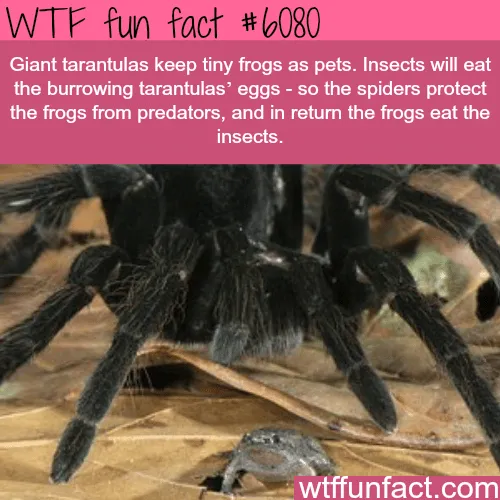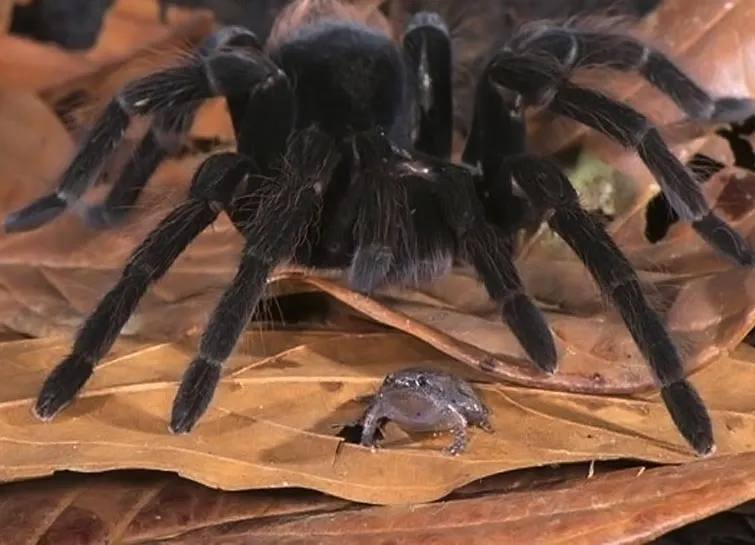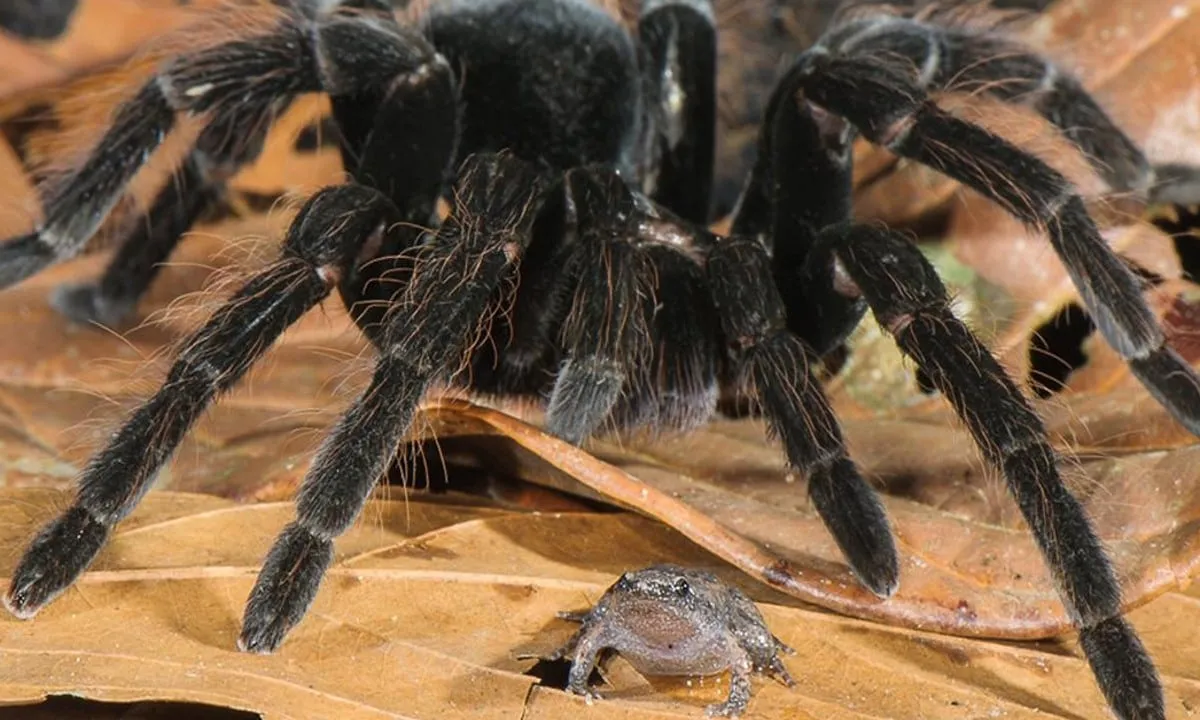The Surprising Truth About Giant Tarantulas and Frogs
The natural world is full of unexpected relationships, and one of the most fascinating is the unlikely bond between giant tarantulas and frogs. While the image of a tarantula might conjure up fears of predation, in some cases, these large arachnids have been observed to form a symbiotic relationship with frogs, protecting them and even sharing resources. This article unveils the top 5 facts about this remarkable phenomenon, exploring the benefits for both creatures and the environmental factors that influence this unique partnership. Prepare to be amazed by the complexity and beauty of nature’s intricate web of life.
Fact 1: Tarantulas and Frogs - A Symbiotic Relationship
The relationship between certain species of giant tarantulas and frogs is a clear example of symbiosis, where two different species interact in a way that benefits at least one of them. In this case, both the tarantula and the frog gain advantages from their association. The tarantula provides protection from predators, and the frog contributes to the cleanliness and well-being of the tarantula’s habitat. It is important to note that this is not a predatory relationship, but a mutually beneficial one, which is a testament to the adaptability of these creatures.
Understanding the Benefits for the Tarantula

Giant tarantulas derive several benefits from their frog companions. Perhaps the most significant is the frog’s role in keeping the tarantula’s habitat clean. Frogs are natural insectivores, and they consume small insects and pests that could potentially bother or even harm the tarantula. This reduces the risk of disease and parasites. Furthermore, the presence of a frog might deter some predators, as the frog’s vocalizations or movements can serve as an early warning system for the tarantula, helping it evade danger. This defensive support is essential for the tarantula’s survival.
Understanding the Benefits for the Frog
For the frogs, the association with the giant tarantula offers significant protection from predators. The tarantula, being a formidable predator itself, effectively guards the frog against threats like snakes, birds, and other larger animals. The tarantula’s defensive behavior, including its intimidating size, venom, and urticating hairs, helps to keep potential predators at bay, creating a safe environment for the frog. Additionally, the tarantula may share shelter with the frog, providing it with a secure place to hide and rest.
Fact 2: Not All Tarantulas Keep Frogs
It’s crucial to understand that this fascinating behavior isn’t universal across all tarantula species. The tendency to coexist with frogs is specific to certain types of tarantulas and is more commonly observed in particular environments. The reasons behind this selectivity are complex, involving factors such as the tarantula’s temperament, the availability of resources, and the presence of suitable frog species in its habitat. The specific conditions must be in place for this unique relationship to flourish.
Which Tarantula Species are Known to Keep Frogs

Several tarantula species are known to exhibit this behavior. Some examples include certain species found in South America and Central America. Research has focused on species that inhabit humid environments with a variety of available food and shelter. These tarantulas often build burrows or live in crevices where they can cohabitate with frogs. Scientists continuously study these species to learn more about their behavior and the drivers behind this interesting symbiotic relationship.
Factors Influencing the Behavior
Several factors can influence whether a tarantula will cohabitate with a frog. Environmental conditions, such as temperature and humidity, play a significant role, as these influence the tarantula’s activity levels and the frog’s survival. The availability of food for both the tarantula and the frog is also critical. When resources are abundant, the tarantula is more likely to tolerate the presence of the frog. The size and temperament of the tarantula and the frog also contribute, as larger and less aggressive tarantulas tend to be more accepting of their frog companions. The absence of other predators is also important.
Fact 3: The Protective Role of Tarantulas
The primary benefit the frog receives from this partnership is protection. The tarantula, with its formidable defenses, acts as a bodyguard, deterring potential predators. This is a crucial advantage, especially for smaller and more vulnerable frog species. The tarantula’s territorial behavior and its ability to defend its home significantly increase the frog’s chances of survival. The presence of a tarantula in the vicinity reduces the likelihood of the frog being attacked by snakes, birds, or other predators.
Defending Against Predators

Tarantulas are well-equipped to defend themselves and, by extension, their frog companions. Their large size, fangs capable of injecting venom, and urticating hairs (which cause irritation) are effective deterrents against most predators. When threatened, a tarantula will typically stand its ground, displaying a defensive posture and, if necessary, striking at the attacker. This aggressive behavior provides the frog with valuable protection, keeping predators at bay and creating a safer environment.
Shelter and Resource Sharing
In addition to direct protection, tarantulas sometimes share their burrows or shelters with frogs. This shared living space provides the frog with a secure hiding place from both predators and the elements. The tarantula’s burrow, often located in the ground or under logs and rocks, offers a stable microclimate, protecting the frog from extreme temperatures and dehydration. The sharing of shelter exemplifies the close bond between these two species, illustrating the mutual benefits of their association.
Fact 4: The Frog’s Contribution to the Partnership
Frogs contribute to this symbiotic relationship in several ways, the most notable being their role in cleaning the tarantula’s habitat and providing nutritional benefits. By consuming insects and other small invertebrates, frogs help maintain a clean and healthy environment for the tarantula, reducing the risk of disease and infestation. This mutualistic relationship is a testament to the incredible ways in which different species can cooperate to thrive.
Cleaning and Pest Control

Frogs are natural pest controllers, consuming various insects, including ants, flies, and other invertebrates. By feeding on these pests, frogs help to keep the tarantula’s burrow or immediate surroundings clean and free from unwanted organisms. This reduces the chances of the tarantula being bothered by annoying insects or contracting diseases. This pest control service is a simple yet effective way in which the frog provides value to the tarantula, indirectly promoting its health and well-being. The image of a frog patiently hunting for insects within the tarantula’s habitat is a perfect illustration of this symbiotic relationship.
Providing Nutritional Benefits
While not always the primary role, frogs can provide some nutritional benefits to tarantulas. Occasionally, a tarantula might consume a frog, especially if the frog is injured or dies. However, it’s important to emphasize that this is not a regular occurrence in the symbiotic relationship, and the frog’s primary contribution is more about pest control and habitat maintenance. It is also possible that the frog’s presence indirectly benefits the tarantula by attracting more prey items to the area, thus ensuring a more consistent food supply for both creatures.
Fact 5: Observing This Behavior in Nature
The observation of giant tarantulas cohabitating with frogs in their natural habitats is an ongoing area of research. Scientists and naturalists actively study these interactions to learn more about the dynamics of this unique relationship. They document the specific tarantula and frog species involved, the environmental conditions that foster these interactions, and the underlying mechanisms that promote co-existence. The aim is to deepen our understanding of the complex interactions within ecosystems and the evolutionary forces that shape them.
Documented Instances and Research Studies

Numerous instances of tarantulas and frogs cohabitating have been documented through field observations and scientific studies. Researchers often use methods like direct observation, camera traps, and ecological surveys to monitor the interactions between these two species. These studies often focus on documenting the frequency of these interactions, the spatial relationships between the tarantulas and frogs, and the benefits each species derives from the other. Detailed analyses help researchers to formulate hypotheses about the evolutionary basis for the symbiosis.
The Role of Environment and Habitat
The environment and habitat play a critical role in enabling the relationship between giant tarantulas and frogs. In areas with high humidity, suitable temperatures, and a diverse range of insects for the frogs to eat, the conditions are ideal for these relationships to thrive. Habitats providing shelter, such as burrows in the ground, under rocks, or within fallen trees, provide the essential protection needed for both species. The availability of these environmental factors determines the probability that this fascinating symbiotic relationship will occur.
Conclusion
The relationship between giant tarantulas and frogs is a compelling example of the complex and often surprising interactions within the natural world. Through protection, cleaning, and resource sharing, these two species have forged a unique bond that benefits both. The study of this phenomenon offers insights into symbiosis, predator-prey dynamics, and the intricate web of life. Understanding this relationship not only enriches our appreciation of biodiversity but also highlights the importance of conserving habitats that support such remarkable interactions. The story of the tarantula and the frog serves as a powerful reminder of the interconnectedness of all living things.
